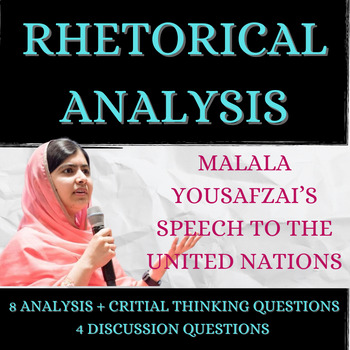Rhetorical Appeals in Modern Speeches | Malala Yousafazai Analysis
- PDF
Also included in
- Help your students understand rhetorical appeals by analyzing modern speeches by current, relevant public figures (great for Women's History Month!). Skills covered throughout these activities include the ability to identify key rhetorical devices such as ethos, pathos, logos, anaphora, allusion, rePrice $8.95Original Price $9.95Save $1.00
Description
In this rhetorical analysis over Malala Yousafzai's speech to the United Nations, your students will apply concepts of rhetoric to a famous speech given by a modern figure.
Rhetorical/Literary Devices Covered (8 questions):
✔️ Ethos
✔️ Pathos
✔️ Logos
✔️ Allusion
✔️ Anaphora
✔️ Parallel Structure
Critical Thinking Topics (4 questions):
the value of education as a force against oppression
the pen > the sword
This activity can be used during a unit study of the book I Am Malala or as an isolated mini-lesson.
In her speech, Malala covers the topics of human rights--particularly the right for girls and women to receive an education, a right which is denied in many parts of the world.
This product includes both the transcript and link to the video of the speech.



